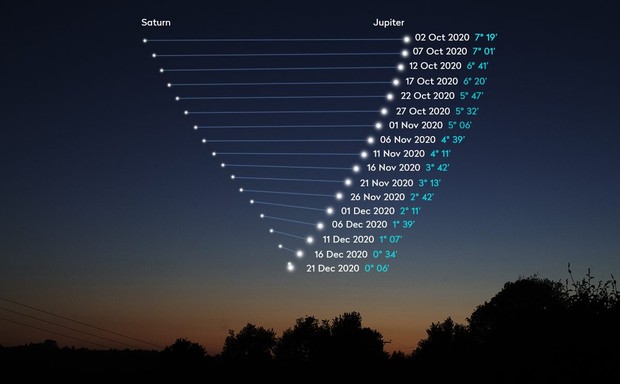If you have been watching the night sky over the course of the autumn and early winter, you may have noticed a pair of bright dots in the southwestern sky. Appearing brighter than all of the stars overhead, these are the two largest planets in our solar system: Jupiter and Saturn. Over the past weeks, the gap between these two bodies has been shrinking, and next week the night sky will display a rare event that has not been seen in nearly 400 years. On Monday, December 21, there will be a conjunction of Jupiter and Saturn, meaning that from our viewpoint on Earth, the two bright dots will appear to merge into one extremely large object. Conjunctions can happen between any two planets, or possibly between a planet and a bright star. However, when the event involves the two biggest planets in our solar system it is called a “Great Conjunction.”

In order for a Great Conjunction to occur, this means that three planets — Earth, Jupiter, and Saturn — need to be lined up almost perfectly in a row. Since these three objects are orbiting the Sun at different speeds, this alignment only happens every 20 years. The precise proximity of Jupiter and Saturn to each other in our field of view can vary among Great Conjunctions, and the 2020 event is special because they have not been this close together in our sky since the year 1623. Historically, the rarity of conjunctions led many cultures to see the events as significant omens; some saw them as good signs, others as bad ones. There is speculation among some people around the world that a Great Conjunction may have caused the “Christmas Star,” the special object that was said to have appeared to the Wise Men, leading them to Bethlehem in the well-known story of Christmas.
You can prepare for the Great Conjunction this week by practicing finding Jupiter and Saturn in your backyard sky. At 5 p.m. EST, the sun will have set, but the sky will be in a stage of twilight. The two planets will be in the direction of southwest, and they will appear brighter than all of the visible stars. By 6 p.m., the twilight will be fading but the planets will be lower in the sky. By 7 p.m., the planets will be so low on the horizon that many of us will not have a clear view of them. Try to note what time this week the planets disappear below your line of sight. You’ll want to go out at least 15 minutes earlier than that on the night of December 21 to ensure that you can witness the Great Conjunction.
To learn more about the Great Conjunction and its possible religious connections, join us at the Treworgy Planetarium for our “Star of Bethlehem” show at 3 p.m., Thursday-Sunday. The show will run through Sunday, December 27.
This post was written by Brian Koehler, supervisor of the Treworgy Planetarium at the Museum.



